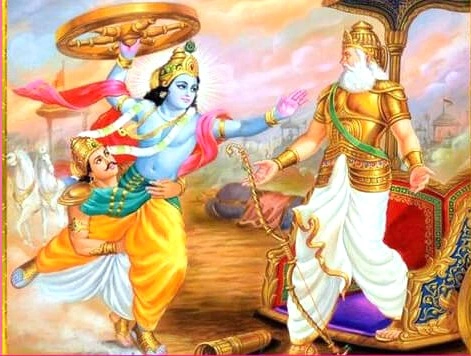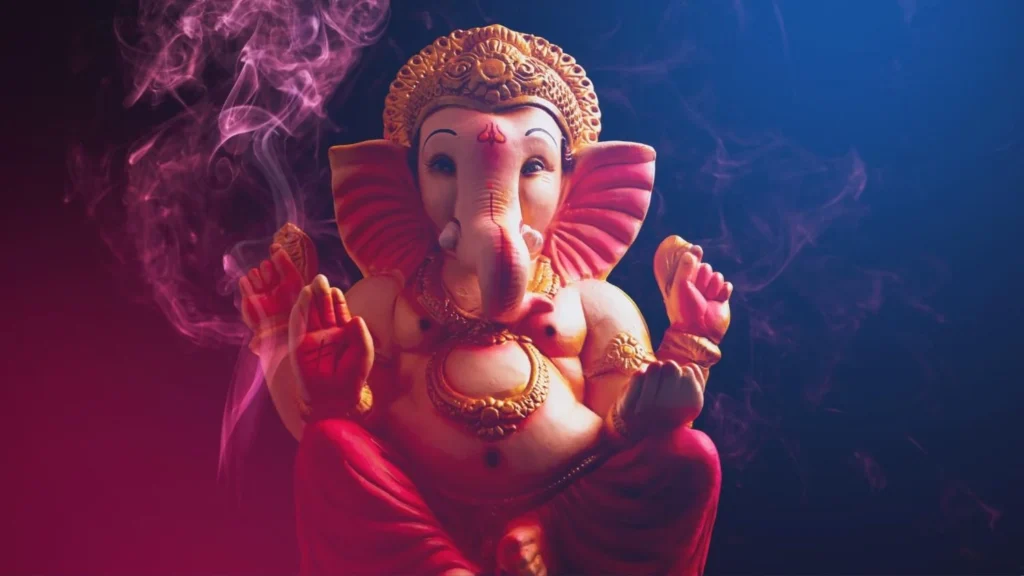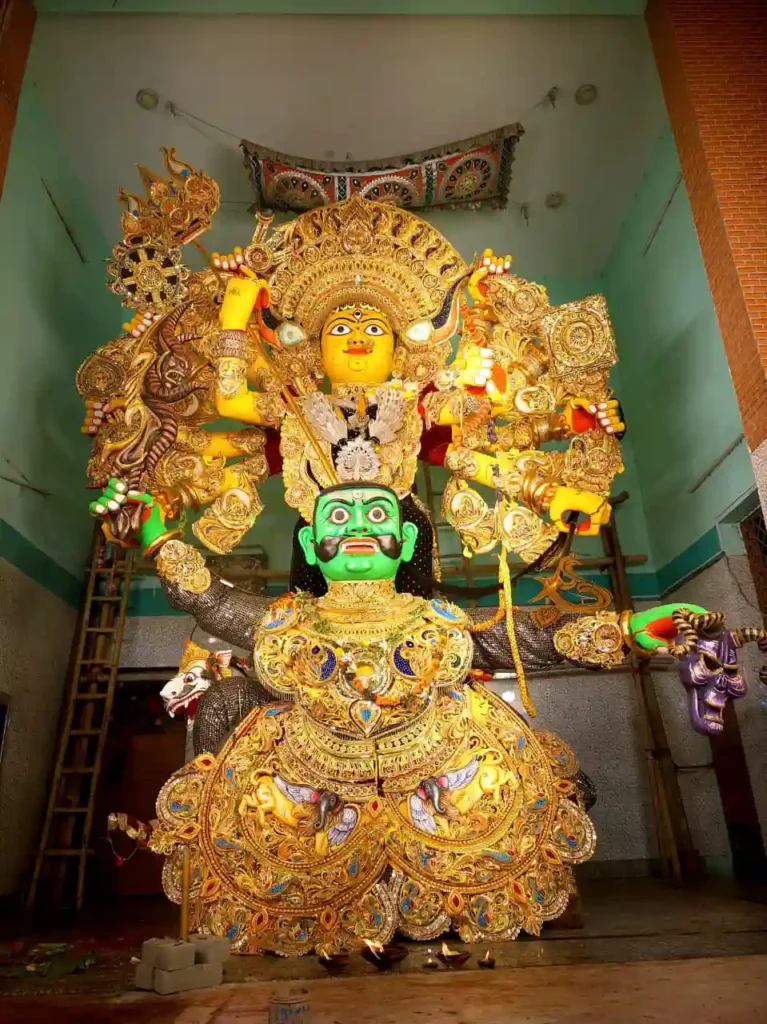
Durga Puja dazzles across India with grandeur and devotion, but in Puri, Odisha, it takes on an identity that is unlike anywhere else. Known as Gosani Upasana, this indigenous celebration is more than a festival; it is a community-driven cultural phenomenon. Here, Durga is worshipped in her folk-inspired form as Gosani, fierce clay idols that embody raw energy, striking iconography, and centuries-old traditions.
Every autumn, Puri’s lanes transform into an open-air museum of artistic imagination and devotion. The goddess appears not as a slim, graceful figure like the other places, but as a powerful, bold, and warlike deity, worshipped alongside Ganga Jamuna, Ganesh and many such idols.
I still remember my own visit vividly: I witnessed the Gosani and Naaga idols and stood amazed at the grace and fierce aura emanating from their eyes. I explored the 22 Gosanis along with Sampati, Saptasira, Budhabudhi, and more. The atmosphere was electric, like, the colours, the music, the devotion, all blending into an experience unlike anything else in India.Table of Contents
The Origin and History of Gosani Puja in Puri
The roots of Gosani Jatra go back to the 12th century, during the reign of King Chodaganga Deva, the legendary builder of the Jagannath Temple. He institutionalized the worship of Gosanis as a unique form of Durga Puja, embedding the festival deeply into the cultural life of Puri.
The word Gosani in Odia folklore carries layered meanings. It refers to Gosamani who represents the collective form of Goddess Laxmi, Durga and Saraswati. It is strongly associated with Tantric traditions. This makes the festival unique.
Unlike Kolkata’s Durga Puja, which became a public (sarbajanina) celebration only in the 20th century, Gosani Puja has thrived for almost a thousand years, shaping the folk identity of coastal Odisha.
The Sahis of Puri don’t just create idols, they tell stories. Each Gosani idol is tied to local legends, folk tales, and even social memory. Children, artisans, and elders all participate, making the festival a living, collective tradition rather than a top-down religious event.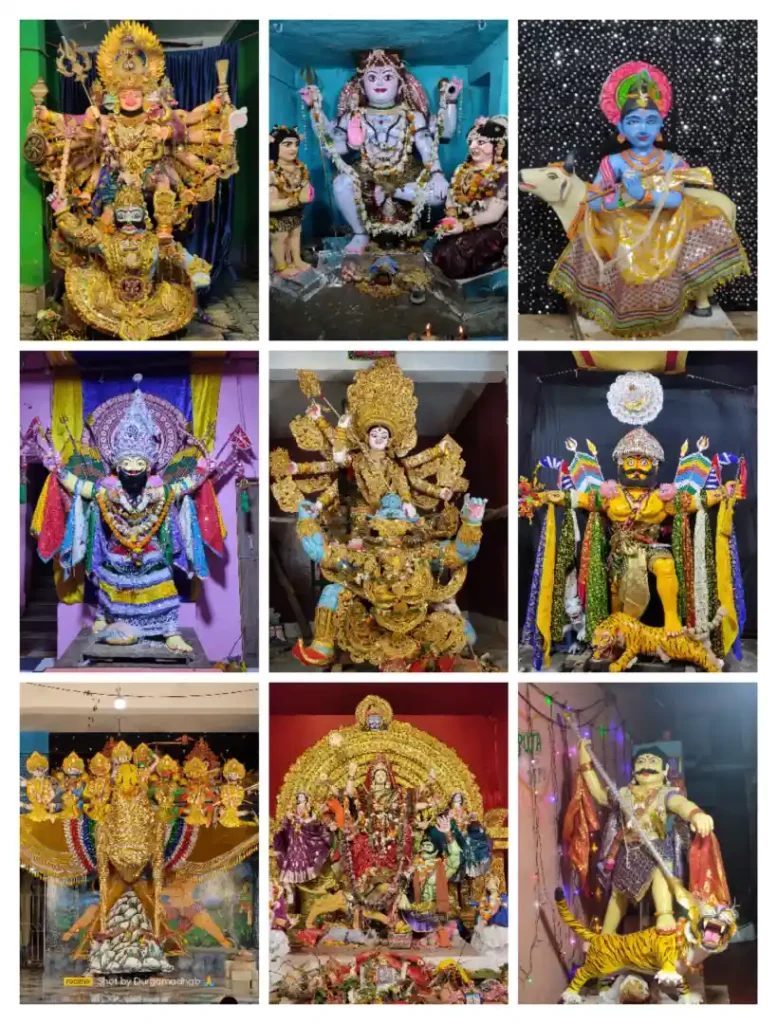
Unique Features of Gosani Worship
Distinctive Clay Idols
- Kakudikhai Gosani – famous for eating a cucumber (kakudi) offered as bhog, this can be seen in her temple right at the south-east corner of the Srimandir. She is believed to the representative of Goddess Bimala outside the temple.
- Barabati Gosani – one of the tallest and most magnificent idols, towering over 20 feet and worshipped in Harchandi sahi. Maa Barabati is known as the elder daughter of Maa Kakudikhai.
- Jahnikhai Gosani – As the name suggests Jahni(ridge gourd) is offered here; you can witness the grand idol in Dolamandap sahi. Maa Jahnikhai is believed the be the younger daughter of Maa Kakudikhai.
- Sunya Gosani – This idol of the Goddess depicts the fight with the demon Mahisasur in air. Sunya indicates space; as the idol is seen mother Durga killing the demon in air.
- Kantakadhi Gosani – where Vishnu is said to remove a thorn from Durga’s foot as Shiva looks on, symbolizing the harmony of deities. The idol is actually the form of Goddess Vanadurga.
- Bhogajaga Gosani – tied to the rituals of food offerings and community feasts. This Gosani is one of the fiercest looking idols.
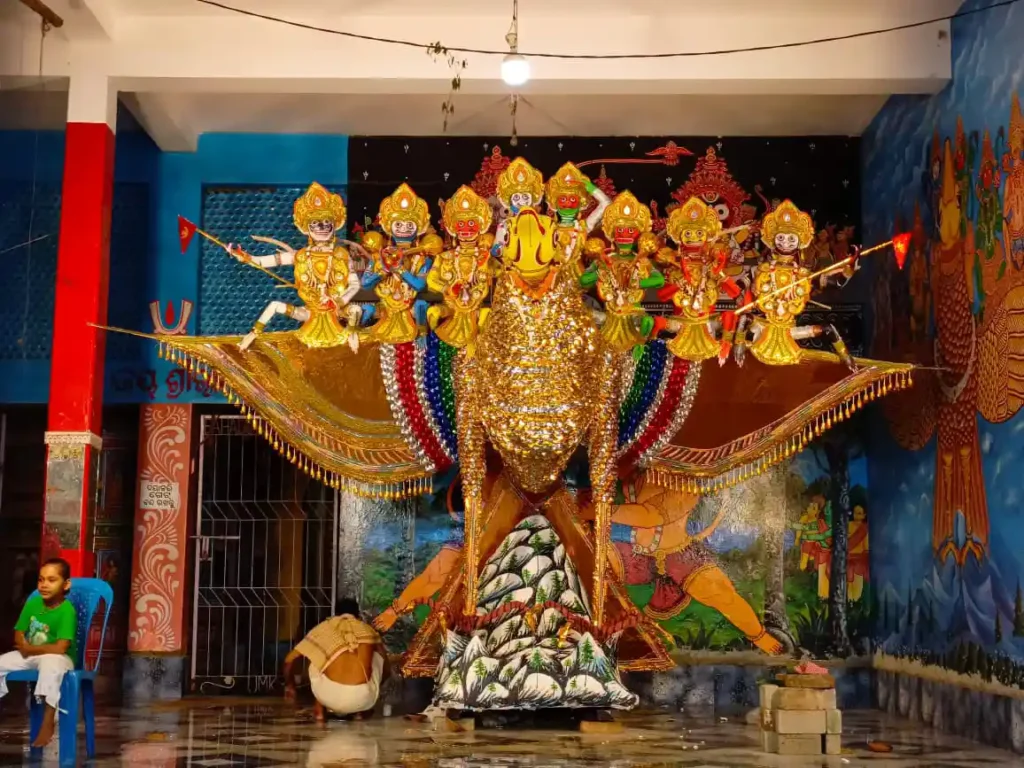
Fusion of Traditions
Iconography of Gosani Idols – A Folk Visual Language
- Intense Eyes: Each Gosani idol has fierce eyes fixed directly on Mahishasura, and notably, they capture the climactic moment of battle.
- Dynamic Posture: With one foot pressing Mahishasura and another placed firmly on the lion, the goddess radiates energy, thereby showcasing her dominance and grace.
- Theriomorphic Demons: Mahishasura is often depicted as a buffalo-headed human, which interestingly echoes the temple sculptures of Odisha.
- Color and Ornamentation: Bright colours and locally crafted ornaments using sola and jari emphasize vitality and folk creativity, while the crown of the deity further enhances her majestic look.
- Weapons: The Goddess wields a Trishul in one hand, piercing the demon’s chest, and additionally, she carries weapons like the Vajra, Sword, Chakra, Conch, and Gada (mace).
Rituals and Celebrations
The Gosani Jatra spans from Saptami to Dasahara, followed by the great immersion. Each day features rituals, music, and processions.
- Kila Anukula: Devotees start making Gosani idols on auspicious days like Sasthi Osha and Radhastami Sunia. They carefully perform each ritual.
- Vanadurga Mantras: Priests recite sacred chants to invoke the goddess. They conclude the three-day worship with rest on Dasami.
- Bimalei Manohi: Devotees re-offer Mahaprasad to Mother Vimala inside Jagannath Temple. Notably, only Puri performs this ritual.
- Sahi Processions: Each neighbourhood parades its Gosani idols through Puri streets with drums, conches, and folk instruments, creating lively energy.
- Sandhi Puja on Astami: Devotees perform rituals at the junction of Ashtami and Navami, reflecting Durga’s fiercest battle.
- Grand Bhasani Yatra (Immersion): On Papankusha Ekadasi, devotees gather idols at Simhadvara (Lion Gate). After lighting Ekadashi Mahadipa, they carry idols to rivers or the sea.
- Sacrifices and Offerings: Devotees present bottle gourd, ridge gourd, fish, Pana, and seasonal fruits. They also offer Sankhudi Bhoga like Khechudi, Macha Besara, Dalma, and more.
My Experience: A Living Folk Culture
Walking through the Sahis and the Badadanda during Gosani Jatra felt like traveling through centuries of history. Indeed, the idols tell stories carved into colour and form. For example, the Naaga idols with their brave and masculine looks, the towering Barabati and Jahnimundia Gosani, and the uncanny charm of Budhabudhi, Sampati, Ravana; all impress visitors profoundly.
Moreover, the air fills with drumbeats and chants, while incense and offerings mingle with the sea breeze of Puri. Clearly, the entire city transforms into a stage where folk imagination and devotion converge. Additionally, every corner of the Badadanda displays vibrant celebrations, while onlookers eagerly follow the processions. Furthermore, the rhythms, colours, and sounds unite seamlessly, creating an immersive experience. Consequently, devotees and tourists alike feel the festival’s energy.
Meanwhile, the other revered Gosanis of Puri include Bhogajaga Gosani, Chakrakota, Jamakota, Mother Harachandi, Maa Vanadurga, Tripura Sundari, Maa Hadabai, Gelabai, Belabai, Maa Panapriya, Mahateswari, and Maa Sitala (the youngest and smallest in height). Significantly, each form carries unique rituals, legends, and artistic expressions. Therefore, they continuously inspire devotion and awe throughout the city.Why Gosani Jatra Matters Today
- It safeguards indigenous artistry, from clay work to sola ornamentation.
- It keeps alive Odisha’s artistry identity, showing how art forms and traditions evolve yet remain rooted.
- It encourages eco-friendly practices, since clay and natural materials return to the earth during immersion.
- It educates future generations, ensuring that children inherit not just rituals but also community spirit and artistry.
People Also Ask – Answers to Common Questions
Q1. What is Gosani Puja in Puri?
Q2. Who started Gosani Jatra in Puri?
Q3. How are Gosani idols different from Durga idols in Bengal?
Q4. How many Gosanis are worshipped in Puri?
Q5. Why should travelers visit Puri during Gosani Jatra?
Conclusion
The Gosani of Puri is not just a religious celebration. It is a living heritage of Odisha, blending mythology, community, and creativity into one unforgettable experience. Each idol tells a story, each procession unites a neighborhood, and together they create a festival that is as fierce as it is beautiful.
If you plan to explore Odisha during Dussehra, make sure you witness Gosani Jatra. Stand before the towering Gosanis, walk through the vibrant streets, and feel the pulse of Puri’s living tradition. It is more than a festival, it is the heartbeat of a city and the soul of Odisha’s rich culture.
